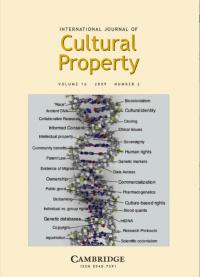The current issue of the International Journal of Cultural Property (16:2) contains a special section on “Decoding the Implications of the Genographic Project for Archaeology and Cultural Heritage,” edited by Julie Hollowell and George Nicholas.
This publication is based on the transcript of a panel discussion that was convened by Nicholas and Hollowell at the 2006 Chacmool Conference with co-sponsorship from WAC and the Intellectual Property Issues in Cultural Heritage (IPinCH) project.
The goal of the panel discussion was to explore the ethical and practical implications of uses of ancient and contemporary human genetic information that arise in the context of such studies as the National Geographic/IBM-sponsored Genographic Project. Seven panelists, ranging from a molecular anthropologist to a bioethicist and a community activist were invited to discuss some of the salient issues, in hopes of moving beyond a polarized debate to generate productive dialogue and delineate further questions about intellectual property, cultural identity, and research ethics. A range of scholars, including two members of the Genographic Project, were subsequently invited to submit commentaries on the transcript. Some of the issues addressed by the panelists and commentators include access to samples, permissions for research and analysis, ownership and dissemination of data, and potential consequences of interpretation of results.
The panelists were Jerome Cybulski (Canadian Museum of Civilization); Carrie Dan (Kamloops Indian Band); Sheila Greer (Champagne and Aishihik First Nations); Debra Harry (Indigenous Peoples Council on Biocolonialism); Anne Katzenberg (University of Calgary); Daryl Pullman (Memorial University of Newfoundland); and Dongya Yang (Simon Fraser University).
Those who provided commentaries on the transcript include Jane Anderson (Law and Society Program, New York University School of Law; World Intellectual Property Organization); Dorothy Lippert (National Museum of Natural History, Smithsonian Institution); Ripan Malhi (Department of Anthropology and Institute for Genomic Biology, University of Illinois Urbana-Champaign); Jonathan Marks (University of North Carolina–Charlotte); Jenny Reardon (University of California–Santa Cruz); Kimberly TallBear (Department of Environmental Science, Policy and Management, University of California–Berkeley); Spencer Wells (National Geographic Society, Genographic Project); and Theodore Schurr (University of Pennsylvania; Genographic Project).
More information on this special issue and on the International Journal of Cultural Property is available at:






